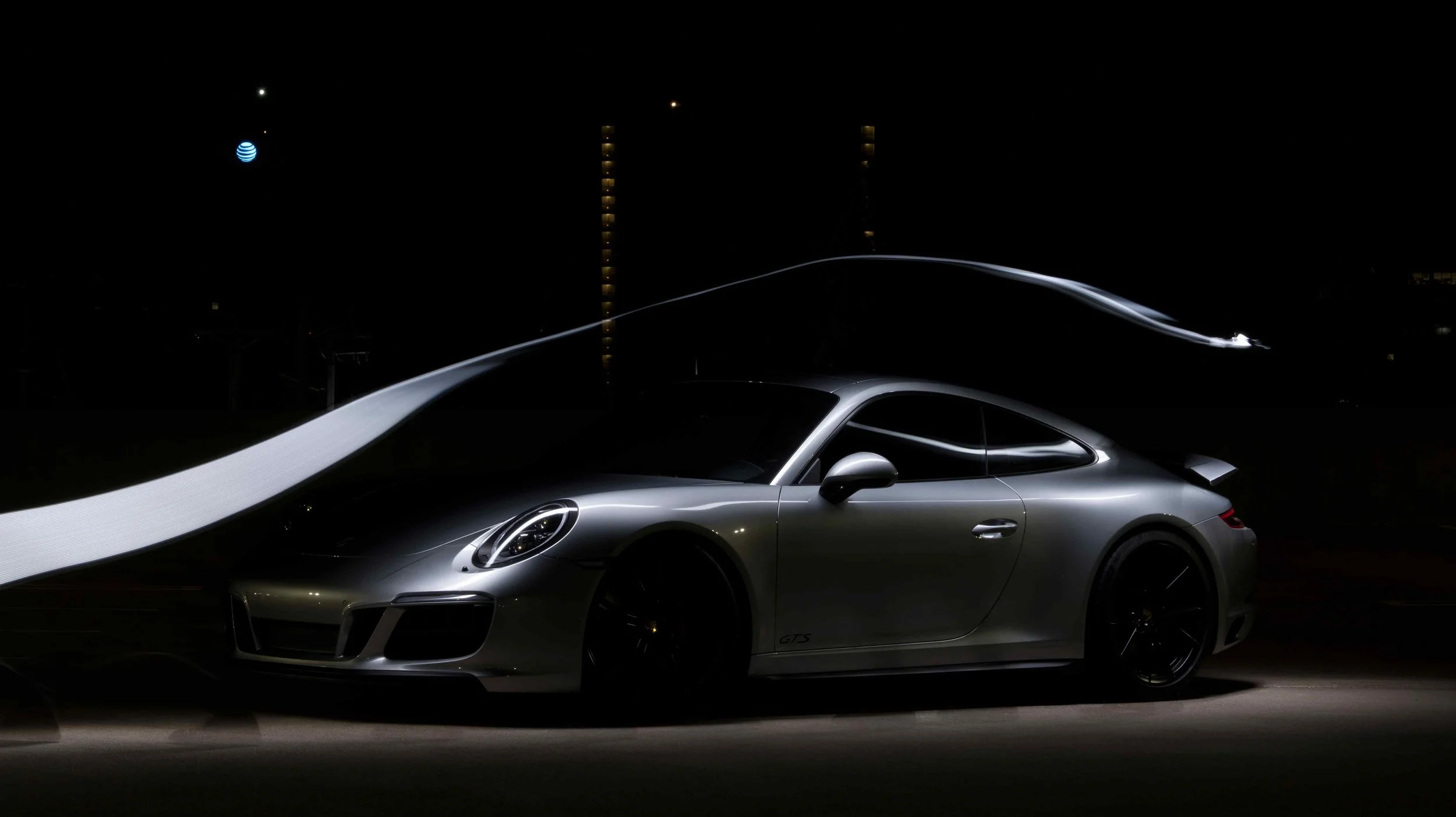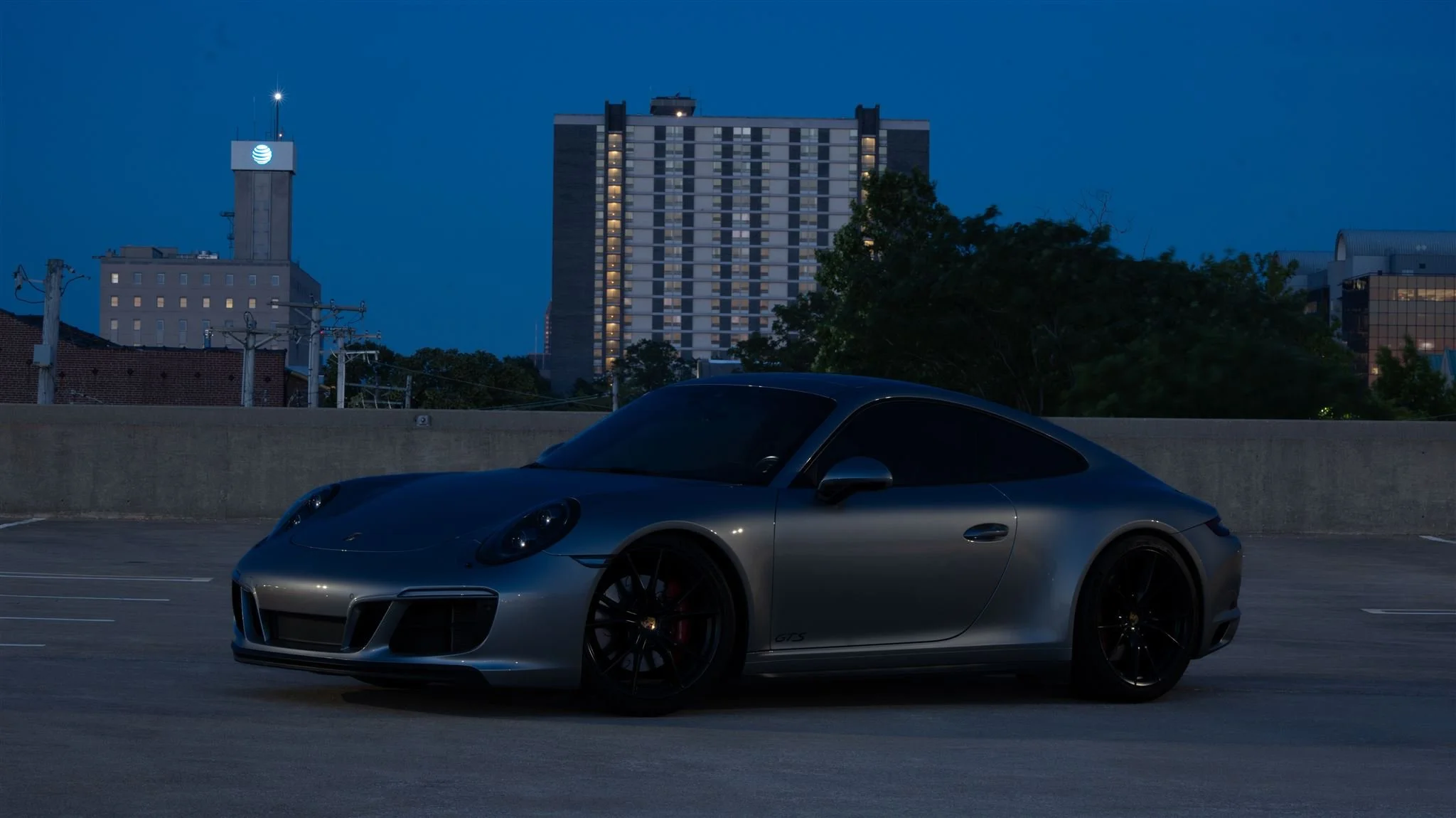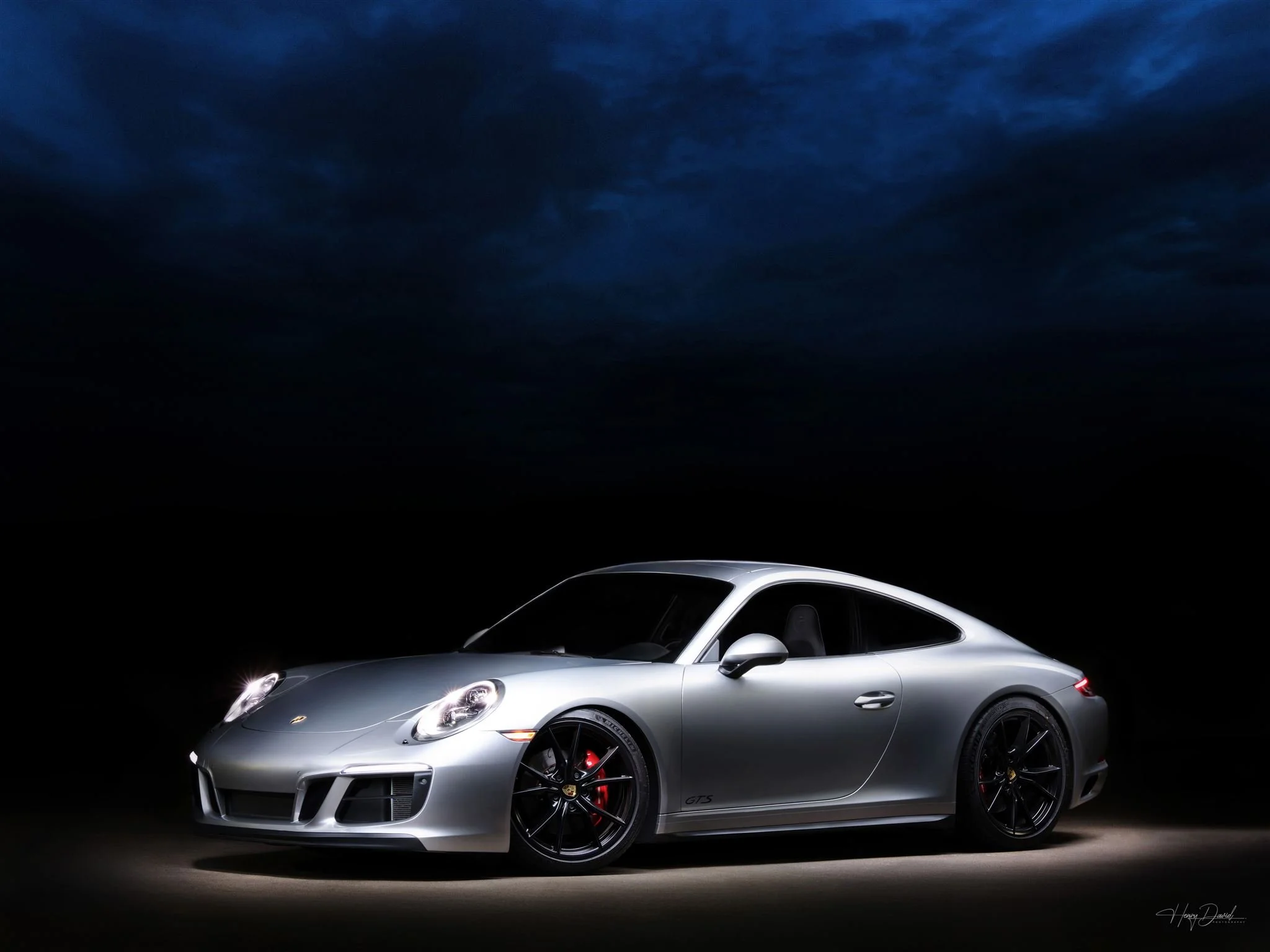Automotive Light Painting Photography with a Porsche GTS: Full Behind-the-Scenes Guide
Learn how we shot a cinematic Porsche light painting image using rooftop location, bulb exposures, and layered light passes.
This behind-the-scenes breakdown of a Porsche GTS light painting session reveals everything you need to know about automotive light painting photography.
From camera settings to lighting techniques, discover how we created cinematic, detail-rich car images using long exposure light painting, perfect for automotive photographers, Porsche enthusiasts, or anyone looking to elevate their car photography.
I recently had the pleasure of working with Chris, the proud owner of a stunning 2018 Porsche GTS, to create a light-painted automotive portrait that blends technical precision with creative storytelling. This blog is a behind-the-scenes look at how we used light painting to turn a car into a work of art, capturing images you simply can’t get with natural light alone.
1. Choosing the Right Location: A Rooftop Advantage
For this shoot, we selected the rooftop of a parking garage. Rooftops are ideal for automotive light painting, flat, expansive, and usually free from distracting clutter. They offer room to move around freely and reposition the car to optimize reflections and composition.
We picked a dark section of the rooftop, well away from overhead lamps and other ambient light sources. The darker the environment, the better, because every bit of unwanted light reduces your control. In light painting, you decide where light falls. Starting with a blank canvas of darkness gives you full creative control to build contrast, drama, and nuance, one stroke at a time.
2. Setup and Tethering
Once we arrived on site, here’s what our setup included:
Tripod to keep the camera absolutely locked down
Tethering with TetherTools to a laptop running Adobe Lightroom Classic for real-time feedback
Lights:
Godox LC500 with modified barn doors for sweeping, broad passes
Eagtac flashlight with Harold Ross modifiers for precision detail lighting
ColorChecker Passport 2 from Calibrite for accurate color calibration
Tethering was key. It let us evaluate every light pass immediately, checking highlight clipping and exposure levels in real time. While we typically aim to ETTR (Expose to the Right) to preserve shadow detail, in light painting we’re extra careful not to blow out highlights, especially since we’re layering multiple exposures.
Safety Tip:
Secure your tethering setup! We used a non-slip pad on a portable table weighed down with sandbags. Even a light breeze can tip over your gear, so plan accordingly.Once on site, we built our setup:
3. Framing, Composition, and Camera Settings
Once the Porsche was in position, we dialed in the technical settings. These are crucial in light painting:
ISO: Lowest native ISO (usually ISO 100) to maximize image quality and reduce noise
Aperture: Between f/16 and f/22, depending on your lens’ diffraction handling. These smaller apertures give maximum depth of field - essential for full-car sharpness.
Lens Choice: We opted for a 100mm prime on full frame for some subtle compression. Zoom lenses or other primes can work too, bring options to decide on-site. For certain angles, using a circular polarizer can help reduce unwanted reflections on the car’s windows or body panels.
Shutter: Bulb mode + remote trigger (we used the Oppilas which is readily available on Amazon), be sure to use a trigger that allows for usage on the Bulb setting.
Additional Camera Settings:
Turn off Long Exposure Noise Reduction – it slows down workflow and can introduce unwanted artifacts
Disable IBIS (In-Body Image Stabilization) – during long tripod exposures, IBIS can cause micro-vibrations
Double-check focus at your working aperture, then lock it in
Don’t bump the tripod, or the car! Even slight movement can ruin layer alignment. You cannot fix misaligned light passes later in post.
Pro Tip:
Work with a teammate, preferably the owner of the car! It’s more efficient, more fun, and safer for your gear. Have your teammate be triggering the opening and closing of the shutter while you control the application of light, or vice versa.
4. Building the Image with Light, in five simple steps
Light painting is the art of layering exposures over time, with each pass selectively lighting a different part of the subject. In post-production, typically in Photoshop, we combine those layers to create a cohesive, polished, and dimensional final image. The brightness and quality of each exposure will depend on three key factors: the size of your light source, how fast you move it, and how close it is to the subject. Keep in mind that the inverse square law applies, light intensity increases dramatically the closer you are, so small distance changes can have a big impact.
1. Base-Fill Pass
We started with broad sweeps using the LC500 to create a soft, even exposure across the entire car. While the light itself isn’t huge, movement over a long exposure makes it act like a massive softbox, smooth and flattering, since it is the size in aggregate captured over time that is ultimately the light source. With light painting, the really cool thing is that you get to determine the characteristics of your light modifier!
Base Fill Layer with relatively even exposure
2. Top-Down Passes
Next, we extended the light wand overhead using a monopod extension - use something sturdy, the last thing you want is for your light to accidentally damage something so valuable as a Porsche GTS.
These top-down sweeps introduced bold contrast and shadows that give the image dramatic structure. These passes often form the foundation of your final look.
Pro Tip: Try multiple angles and elevations to give yourself options.
Look for a clean light streak that follows the contour of the car, it will likely be the “hero” pass in your final composite. Also watch the shadow cast on the ground, it forms its own visual line, so make sure it looks intentional.
A Top-Down Pass over with the Godox LC500 safely extended over the Porsche GTS yields dramatic results.
3. Detail & Accent Lighting
Now we fine-tune. Use a smaller flashlight to light:
Wheels and rims (have the driver slightly rotate them for a strong angle of the full wheel)
Interior seats, dash, and steering wheel
Badging, trim, emblems, and surface highlights
We had Chris turn on the headlights and taillights to capture those iconic glows. These add life and realism when blended into the final composite.
Ask the car owner what details matter most to them. Chris, for example, pointed out the beautiful leather stitching on the interior as well as the rear spoiler, so we made sure to capture those elements.
4. Rim Lighting / Backlighting
One of the most cinematic touches: a subtle rim light from behind. This outlines the vehicle and creates beautiful separation and pop from the background.
Rim Lighting from Behind the Porsche for a dramatic outline.
5. Capture a “Before” Image
Before wrapping the lighting, take a shot without any light painting. Let the ambient light (or sky) expose naturally. This gives you a dramatic “before” for comparison, and can serve as a base for compositing a clean background later. You can also do this step before starting the light painting as your framing up your image.
5. Post-Processing: Where the Magic Happens
Once back in the studio, we import RAWs into Lightroom and apply a calibrated color profile for the light source. Make basic exposure corrections to preserve your highlight detail and shadow depth.
Photoshop Compositing
In Photoshop, each light pass becomes a layer. Using masks, we selectively reveal only the best-lit parts from each. This additive process builds up a clean, dimensional final image.
We recommend working in 16-bit sRGB throughout for best results and smooth tonal transitions.
Sharpening & Background Work
Once the image is composited and flattened, use AI-assisted sharpening tools like Topaz or Photoshop Neural Filters. Be gentle, over-sharpening can introduce banding in smooth gradients like skies or reflections. Apply sharpening selectively to details only, using layer masks.
If needed, composite in a new background. You can often use the original, but in our case, we replaced the sky with a cloud layer for added atmosphere. Match perspective, focal length, lighting temperature, and shadow direction to blend it believably.
Final Thoughts
Light painting a car like Chris’s Porsche GTS is a perfect marriage of technical precision and creative expression. It requires planning, teamwork, patience, and a genuine love for the craft and subject.
Unlike standard car photography, this approach is slow, deliberate, and deeply satisfying. You're not just capturing an image, you're building one, piece by piece. It’s a chance to fall in love with photography all over again.
If you're a car enthusiast, creative professional, or just someone who wants their vehicle immortalized in this otherwise unachievable, cinematic style, let’s connect. I’d love to collaborate and create something truly one-of-a-kind for your prized machine.








